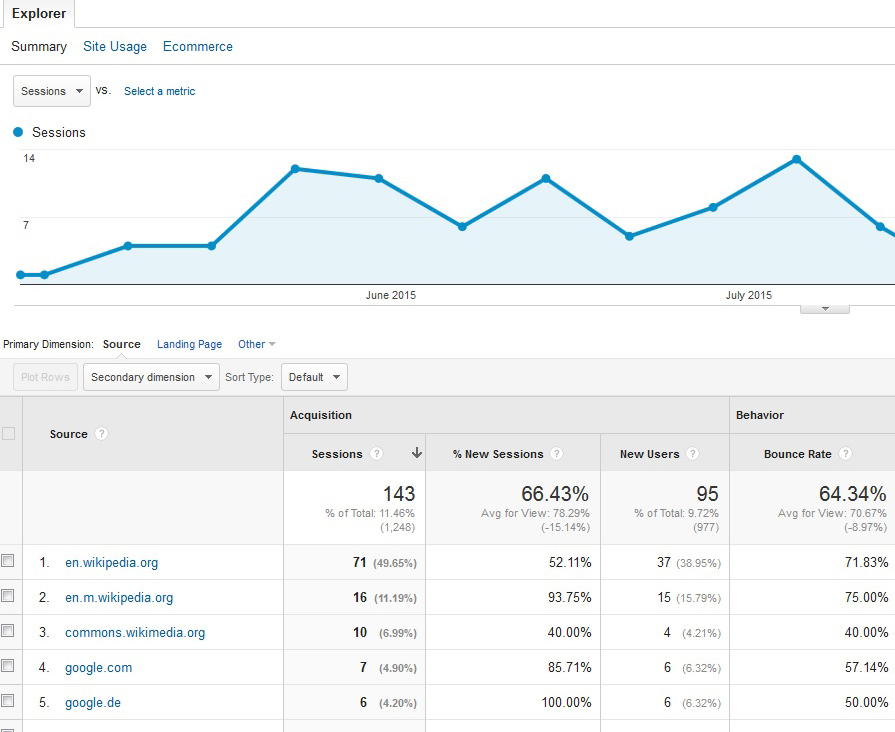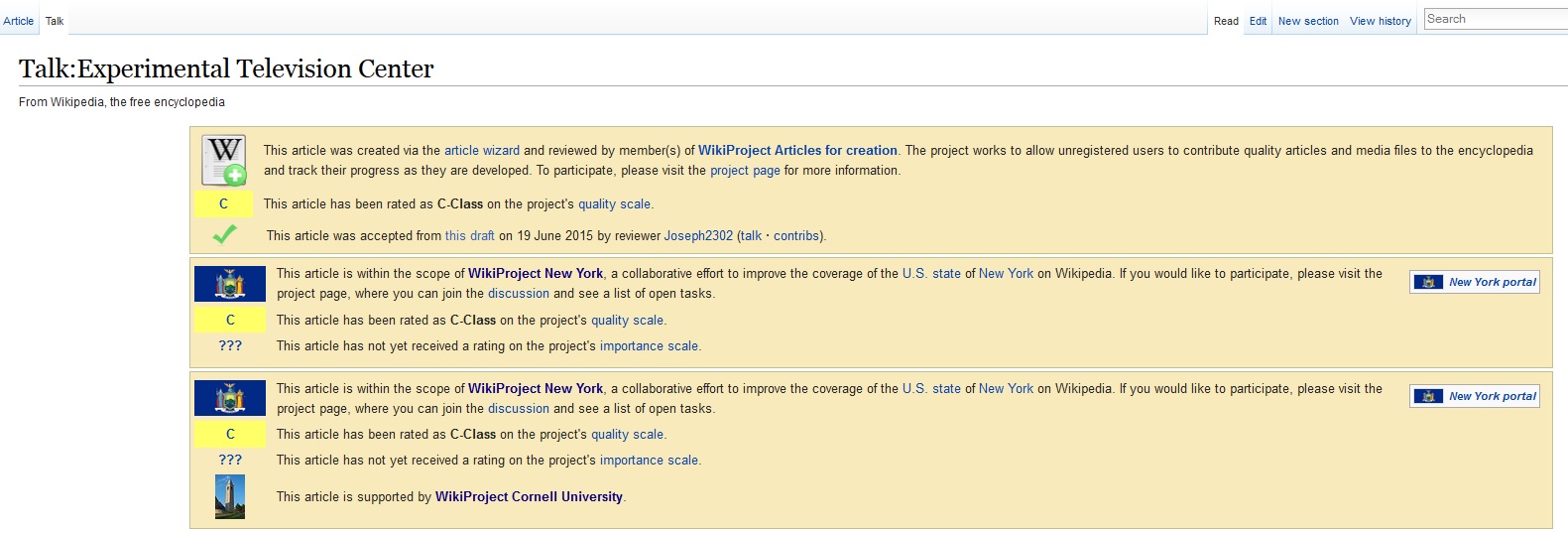Using Wikipedia to Increase the Visibility of CUL- Digital Collections: Take One
As part of an ongoing effort to better promote CUL’s digital collections, we have embarked on an initiative to strategically link newly digitized content to appropriate entries within Wikipedia. Going forward, this will be integrated into our overall digital project workflow, to guarantee broader points of access to our collections. Wikipedia is ideologically aligned with the library vision for free access to knowledge (see slide 6) and consistently seeks reliable sources. Libraries and archives are excellent locations to find reliable sources. Wikipedia, the 7th most popular website on the internet with over 500 million visitors per month, is one of the best online spaces to make our resources visible.
Many examples in this direction come from the GLAM project (the acronym for Galleries, Libraries, Archives, and Museums) and the Wikipedia Library Project. Both are projects that Wikipedia runs in collaboration with many cultural Institutions (see more cases here and here).
What is Wikipedia?
Wikipedia is a multilingual, web-based, free-content encyclopedia that is written by its users on a collaborative basis.
Wikipedia has no firm rules but instead principles and policies that have been written by the community. According to these principles, the edits are required to be treated as knowledge addition to an encyclopedia. In addition, these edits have to be written from a neutral point of view which includes different perspectives about a subject and follows specific rules like verifying and using a reliable source, avoiding original research, etc.
Moreover, Wikipedia consists of free content that anyone can use, edit, remove and distribute. Free content is defined as “content that does not bear copyright restrictions on the right to redistribute, study, modify and improve, or otherwise use works for any purpose in any medium, even commercially”. All the shared content, apart from specific exceptions (see fair use), from the upload material to the written articles has to be under a free copyright license or under the public domain.
Communication among the members of the community is inevitable and desirable. For each article in Wikipedia, there is one more page regarded as the “talk page”, where improvements on the article are discussed.
CUL’s First Project
Working closely with collection curators, we began with an effort to increase the visibility of the Experimental Television Center Archive website. The ETC was one of North America’s preeminent organizations for video art, from 1968-2001, with more than 3,000 media artworks on video tapes and DVDs. The center’s media arts collection has since been archived and is housed now at the Rose Goldsen Archive of New Media Art through Cornell University Library’s Division of Rare and Manuscript Collections.
We first questioned the type of information the ETC website provides: Could this information fit in an encyclopedia? What type of edits or references could we provide to relevant Wikipedia pages? Could some of the website’s information improve the quality of Wikipedia? In addition, is the collection material available in terms of copyright-use? Could we upload copyright-free material (for example images of the collection) to Wikimedia Commons, which is the online repository of free-use images, sound, and other media files in Wikipedia?
Moreover, we tried to find correlations by subject between the Experimental Television Center Archive and relevant topics in Wikipedia. There were four working pillars that we followed to find relevant articles:
- Articles on Wikipedia about a plethora of artists that were involved with the organization. (Out of a total 117 artists, 30 of them have their own Wikipedia article).
- Articles about the image processing tools that were used by ETC.
- Articles relevant to new media art preservation.
- Articles about the ETC itself, the Rose Goldsen Archive of New Media Art and the CUL.
We excluded the use of any visual material because of copyright issues. In addition, due to the Wikipedia policy about the use of external links, we also excluded almost any use of such links since we couldn’t provide direct access to the media collection. We worked mostly with small edits on existing Wikipedia Articles enriching them with relevant information and references. An example, where an edit addresses the needs of an existing article is shown below: (Enlarge images by clicking on them)

This label indicates that the article has unclear sources and asks for help to improve it by introducing more precise citations. (Enlarge image by clicking on it).

This is an example of a minor edit to the existing article, which provides citations. (Enlarge image by clicking on it).
In addition, we expanded an existing article; however, this expansion was considered promotional, and we opted to revise. To do so we had to understand better the cause behind the conflict and the rationale for the appropriate changes according to the advice and intervention of the people who run the Wikipedia Library Educational Program. This program provides a self-guided curriculum for students and cultural organization employees who work to profile library, archive and special or other cultural collection materials. In going through these materials, we learned best practices to follow and pitfalls to avoid. It is very easy for one to get lost in Wikipedia’s plethora of information; this navigation skill was a systematic reference point for resolving the challenges we encountered.
Creating an article in Wikipedia for the first time
Searching through Wikipedia for articles related to the Experimental Television Center (ETC), we realized that there were plenty of articles referring to ETC (because of its long history throughout the years in the field of new media art); however, there was no article on the center itself. More precisely, it seems that there was an article, which was deleted some years ago.
When one writes his/her first article in Wikipedia, there are specific rules that one should follow or avoid, along two main directions: on one hand, there are all these technical rules about the right use of punctuation and syntax, how you edit the references and footnotes, how to follow an appropriate structure in your article, how to add an image, etc. On the other hand, there are all these rules that refer to the Wikipedia policy: for example to avoid promotional language or the use of copyrighted material (like an older article that you wrote for the same subject and is published in another source, or links to copyrighted materials, etc.). Moreover, the article created is available under the Creative Commons Attribution-ShareAlike License; it is open to changes, improvements and collaborative editing and it is free to be used and be shared.

This is a metric tool that Wikipedia provides for the purpose of recording Wikipedia article traffic
Since this was our first article, we submitted a draft for review to the WikiProject Articles for Creation, which provides a peer review on the “for creation” article, it neither accepts giving a classification for its quality or declines the article as unsuitable for Wikipedia.
First Results
Despite the fact that the presence of the ETC Archive website has increased on Wikipedia and many links have been disseminated across many relevant articles, we are not ready yet to comment with numbers. With the help of Melissa Wallace, who gave a first answer to the unresolved (for me) question about why we don’t see Wikipedia as a referral source in Google analytics, we are in the process of exploring an optimal solution.
Second Project (ongoing)
The second project involved the Cornell Collection of Antiquities website. This collection of antiquities – with originals and reproductions– from the ancient Mediterranean, is divided into four parts: Ancient Coins, Plaster cast, Gems and Squeezes. Apart from the collection itself, the website provides relevant information about these objects. Thanks to the help of Peter Hirtle, who thoroughly answered our questions concerning copyright issues, we concluded that, since images of 3D works are protected by copyright, they can be used in Wikipedia, only if they have a free license on them, such as CC0 (Public Domain Dedication); CC BY (Attribution); or CC BY-SA (Attribution-Sharealike) license). We are awaiting the arrival of Amy Dygert to determine CUL’s policy for this.
Up to now, we have worked only with the Gems collection, adding external links on Wikipedia-relevant articles to communicate the information contained on the website. In addition, we made small edits with footnotes and we added bibliography to the “further reading” section to Wikipedia articles associated with this topic. At this moment, there are a small number of Wikipedia articles (more or less 10 articles) that hold links and information from the Collection of Antiquities. Hence, statistics numbers are very limited. Nevertheless, Wikipedia is the first referral source in Google Analytics.

First results from google analytics: Collection of Antiquities Website has 97 sessions from Wikipedia, out of its total 143.
Conclusions: Thoughts from this first engagement with Wikipedia
- Go with the flow: During the first few months I was reading through Wikipedia pages, I focused on better understanding the Wikipedia culture and identifying ways to contribute in a CUL context. I also met the Wikipedia Ambassador at Cornell, Meghan Sitar, who kindly offered me her time, introducing me to the general picture of Wikipedia. Despite this preparation, a main motto of Wikipedia is to “BE BOLD”, so what you really have to do is to jump in the water and just go with the flow.
- Explain yourself to others: In Wikipedia there is no account used by an organization or a group of people. Each individual has her/his own account and a history of contributions. It is always an individual – the Wikipedian-, who works with others in different projects (for example the Wikipedia Cornell Project) and all together for the encyclopedia; Therefore, I created my user page, explaining my relation to Cornell and my intentions.
- Conflict of interest: Any user new and unfamiliar with Wikipedia culture is possible to come across conflicts; maybe this is part of the learning process in setting your feet on new grounds. On the one hand, the Wikipedia community has an advanced culture of combating “link spam”(see slide6). On the other hand, the professionals of cultural institutions are interested in highlighting the visibility of their collections. A common ground can be found in their communal vision of disseminating knowledge and reliable sources.
- Despite any critiques that the Wikipedia project may receive (such as the articles’ quality, information updates, bureaucracy, vandalism, etc. – see more here), it is the largest free source of information in the world and it is always a work in progress.
All the above examples constitute a first effort to incorporate Wikipedia in the drive to enhance the visibility of the digital collection. I feel that there is plenty of room for improvement. From our side, we could continue editing (such as inserting footnotes, external link and further reading) material from CUL collections to related articles to continue familiarizing ourselves with Wikipedia culture. Furthermore, we could focus on the particular collections, which can be used in Wikimedia Commons (free copyright) to increase our online visitors. In addition, we could examine the possibility of participating in GLAM-project or/and Wikipedia Library projects. Finally, I have the impression that, at this time, there is a very important ongoing effort in restructuring the digital portal of CUL digital collections, that could be a potential hub through which CUL collections can link to Wikipedia.
Eirva Diamessis (& Danielle Mericle)

